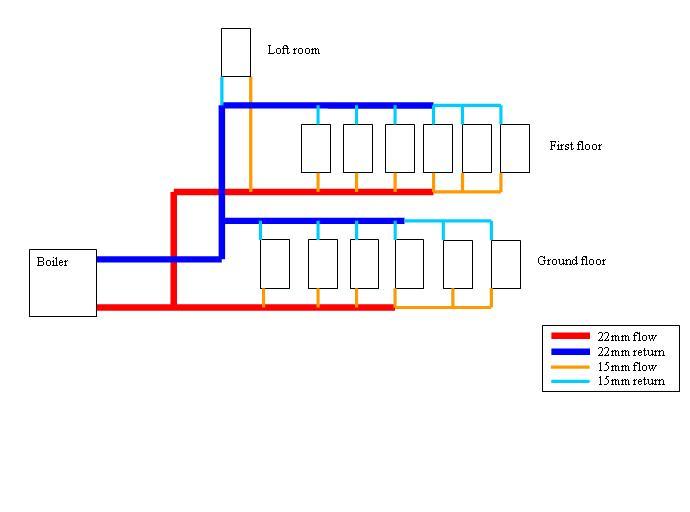Hi,
I recently moved into a new house and I want to update the central heating pipes… the boiler is only a couple of years old (Gloworm Ultracom 30cxi) so I don’t intend replacing that but there’s a single pipe system running round the whole house over the floorboards so I’m planning on replacing that with a 2-pipe flow & return arrangement hidden under the floors.
After doing a bit of research, I’ve come up with the following plan…. using plastic speedfit pipe for the lot (apart from the first couple of metres from the boiler), starting with 22mm from the boiler, splitting to 2x22mm supplies for the upstairs and downstairs separately, teeing off in 15mm for each rad and then the end of each run reducing to 15mm to supply the last 2 rads – see diagram.
As this is the first time I’ve done anything on this scale, I have a couple of queries:
1) The boiler’s flow outlet is 22mm but has then been increased to 28mm after about 20cm – would it be better to continue with 28mm to the split point or as the initial outlet from the boiler is 22mm, is increasing it to 28mm relatively pointless?
2) Is it OK to split the flow & return pipes (22mm) into two 22mm runs to supply the upstairs and downstairs separately or would it be better having a single run for the whole house?
3) Does my planned arrangement look ok in general??
Any advice would be greatly appreciated.
Many thanks
Dave
I recently moved into a new house and I want to update the central heating pipes… the boiler is only a couple of years old (Gloworm Ultracom 30cxi) so I don’t intend replacing that but there’s a single pipe system running round the whole house over the floorboards so I’m planning on replacing that with a 2-pipe flow & return arrangement hidden under the floors.
After doing a bit of research, I’ve come up with the following plan…. using plastic speedfit pipe for the lot (apart from the first couple of metres from the boiler), starting with 22mm from the boiler, splitting to 2x22mm supplies for the upstairs and downstairs separately, teeing off in 15mm for each rad and then the end of each run reducing to 15mm to supply the last 2 rads – see diagram.
As this is the first time I’ve done anything on this scale, I have a couple of queries:
1) The boiler’s flow outlet is 22mm but has then been increased to 28mm after about 20cm – would it be better to continue with 28mm to the split point or as the initial outlet from the boiler is 22mm, is increasing it to 28mm relatively pointless?
2) Is it OK to split the flow & return pipes (22mm) into two 22mm runs to supply the upstairs and downstairs separately or would it be better having a single run for the whole house?
3) Does my planned arrangement look ok in general??
Any advice would be greatly appreciated.
Many thanks
Dave


